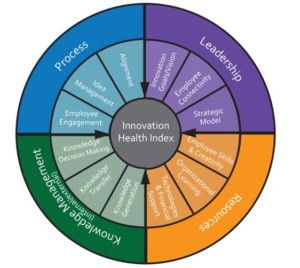Why are some companies continually coming up with new, dynamic products and services, technologies and business models? And, why are others always late to the party? Why do some companies lead with one innovation, and then falter before developing the next?
We believe we have some answers for you. At InnovationOne, we have just completed our 2017 Global State of Innovation Survey. Our goal was to understand which companies around the globe are currently the innovation leaders and why. And, which countries.
 This work is an extension of our foundational research on innovation and our 2013 study on innovation with Fortune 1000 companies, which was conducted by InnovationOne founder, C. Brooke Dobni, PhD. This foundational research led to the creation of a scientifically based model of an organization’s culture and capability for innovation. (At right).
This work is an extension of our foundational research on innovation and our 2013 study on innovation with Fortune 1000 companies, which was conducted by InnovationOne founder, C. Brooke Dobni, PhD. This foundational research led to the creation of a scientifically based model of an organization’s culture and capability for innovation. (At right).
Based on this model, we can assess, benchmark and provide reliable guidance to companies on how they can improve their culture and capability for innovation. Dr. Dobni’s research also showed that highly innovative companies, which have strong cultures of innovation, have higher financial result than low innovation companies.
We also discovered that roughly 70% of companies do not have a strategic approach to innovation. Their executive leaders do not take it seriously and don’t communicate their innovation strategies (when they exist) to their workforce and ecosystem. Furthermore, they do not invest in innovation, organizational learning, ideation and knowledge management, analytics, collaboration technologies, nor processes to align and commercialize new innovations. Consequently, they fail to innovate or occasionally get lucky with an innovation.
Our recently concluded global survey, has a sample of 905 qualified respondents from 10 countries. The countries were: Canada, China, France, Germany, India, Italy, Japan, Spain, UK/Ireland, and the United States. In order to learn what the most highly innovative companies were doing, as opposed to less innovative companies, we conducted a statistical cluster analysis. (Simply stated, our cluster analysis looks at the average scores across all the questions of the survey and categorizes organizations by innovation levels, either being high, or low. These groups are statistically distinct).
Here is what we discovered:
Companies that are innovation leaders clearly stand out from non-innovative companies in our cluster analysis. The highly innovative companies rated the result of their approaches as very successful. They had an average of 8.2 on a 10-point scale. Low innovation companies rated their success as an average of 5.9 on a 10-point scale.
As the chart below indicates, highly innovative organizations succeed because they:
- Are led by executives who provide the strategic focus, context and investment for innovation.
- Build strong collaborative cultures of innovation, as well as supportive external ecosystems.
- Employ contemporary technologies and methodologies for innovation.
- Regularly gather intelligence from experimentation and “big data.”
- Use analysis, measurement and metrics for innovation decision-making and management.
- Enjoy big advantages by discovering the “next big thing.”
- Effectively manage their global innovation projects across multiple cultures.
- Persist with innovation investment and effort!
Yet, highly innovative companies still struggle with scientific discovery, that is breakthroughs in scientific research.
By contrast, low innovation organizations do not comprehensively and consistently invest and persist with innovation. They report a “no-to-little-use” for developing innovative cultures, crowdsourcing, implementing innovation management software, deploying metrics, and so on. They struggle with using big data, design thinking, and engaging with the external ecosystem.
Highly innovative companies report success using a variety of innovation technologies and methodologies, as illustrated in the chart below. Low innovators do not.
 What is the moral of our study? If you want to be innovative, you need to be serious about it. Invest in it. Develop your organizational culture and capability for innovation by investing in your hard capital and your workforce, developing relationships with your external ecosystem, and using contemporary collaboration tools, analytics and project management software. You must persist!
What is the moral of our study? If you want to be innovative, you need to be serious about it. Invest in it. Develop your organizational culture and capability for innovation by investing in your hard capital and your workforce, developing relationships with your external ecosystem, and using contemporary collaboration tools, analytics and project management software. You must persist!
If your organization does not innovate, you have surrendered to the status quo. Surrendering is a failing business strategy because your current competition, or new disruptors to your industry, will blow past you.
By the way, which countries in our sample are the most innovative? Look below. India is the clear winner, followed by Italy, Spain and the United States.
 In the weeks ahead, we will be continuing to scour the survey responses to identify the other factors that enable innovative companies-and countries-to be innovative. Please sign up for our newsletter if you want to follow our scientific learning on innovation, and how it drives profitable growth.
In the weeks ahead, we will be continuing to scour the survey responses to identify the other factors that enable innovative companies-and countries-to be innovative. Please sign up for our newsletter if you want to follow our scientific learning on innovation, and how it drives profitable growth.
What has been your experience with innovation? Which methodologies and technologies are you using? Which have been more helpful than others? Join the conversation.
Victor Assad is the CEO of Victor Assad Strategic Human Resources Consulting and is a Managing Partner of InnovationOne. He consults on innovation, global talent management, developing agile leaders and teams, and other strategic initiatives. Questions? Please e-mail Victor at [email protected] or visit www.victorhrconsultant.com. For innovation visit www.InnovationOne.io.


